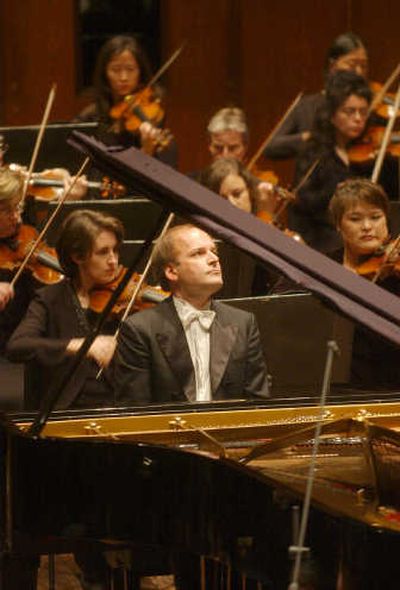All aboard

The Spokane Symphony steams into its 2007-08 season tonight starting with the most famous train-inspired work for symphony orchestra and concluding with a mini-festival of works by Maurice Ravel.
Music Director Eckart Preu will open the concert at the INB Performing Arts Center with Arthur Honegger’s “Pacific 231.”
The orchestra will be joined by pianist Louis Lortie for Ravel’s two concertos for solo piano. Concluding the program, Preu will conduct Ravel’s famed orchestration of Mussorgsky’s “Pictures at an Exhibition.”
“By beginning our season with ‘Pacific 231,’ we’re not quite saying goodbye just yet to the Opera House,” Preu says. “But it shows that the train is about to pull out of the station.”
The INB Center (formerly the Spokane Opera House) stands on the former site of the Great Northern Railroad Depot.
The symphony will play its final classics concert there on Oct. 19 before the series moves to the newly remodeled Fox Theater.
Honegger was one of a number of composers in the 1920s who were captivated by heavy industrial technology.
“Pacific 231” was originally the first of three short orchestral works, each titled merely “Mouvement Symphonique.” But Honegger came to see it as expressing the energy and power of a great locomotive, such as the model Pacific 231 that pulled many of Europe’s biggest trains.
“Honegger said that he was just writing an experimental symphonic movement that showed rhythmic acceleration while the movement itself slows down,” Preu says.
“But it’s not just an experimental trick, though. Honegger made a really fascinating piece. It’s a great work; that’s why it has stayed in the repertoire.”
Honegger was Swiss, but he became effectively French from the time he was a student.
The rest of tonight’s concert is devoted to the work of Honegger’s older contemporary, Maurice Ravel, who was Basque and Swiss but became the very model of a French composer from the time he was a student.
The Canadian-born Lortie is making a belated Spokane debut. He was scheduled to perform with the symphony in 1994, but was forced to cancel because of illness.
Lortie was born in Montreal, making his debut there at 13. He subsequently won first prize in the Busoni Competition in 1984 and was also a prize-winner in the Leeds Competition that year. He has made more than 30 recordings, including a nearly completed series of all 32 Beethoven sonatas.
“Louis Lortie is the Ravel expert,” Preu says. “He has recorded all of Ravel’s piano music and he plays the two concertos everywhere. So we are really happy that he is playing both concertos here.”
Ravel wrote his Concerto for Left Hand Alone on commission from the Austrian pianist Paul Wittgenstein, who lost the use of his right arm in the First World War. The Concerto in G was written for Ravel’s own American tour in 1928.
“When you look at the score of these concertos,” says Preu, “you think, ‘Oh, that is really dissonant!’ or ‘It doesn’t look as though there is very much melody there.’
“But when you hear the music played, it doesn’t sound dissonant at all, and there seems to be full of melody all the time.”
Tonight’s final work, the orchestration of Mussorgsky’s “Pictures at an Exhibition,” is another project Ravel undertook at the same time he was writing the concertos.
Modest Mussorgsky wrote “Pictures at an Exhibition” in 1874 as a suite for solo piano in memory of his friend, the painter Victor Hartmann. But the piece is known to most audiences from the version Ravel made in 1929 on a commission by the Russian conductor Serge Koussevitsky.
“Since Ravel, there have been lot of other efforts at orchestrating ‘Pictures,’ by people like Stokowki and Ashkanazy and others who think Ravel’s doesn’t sound Russian enough,” Preu says.
“I have looked at their orchestrations, and I think – Russian or not – Ravel sounds right.”
Associate Conductor Morihiko Nakahara will discuss the music on tonight’s program as part of the Gladys Brooks Pre-Concert Talks series in the INB auditorium at 7 p.m.